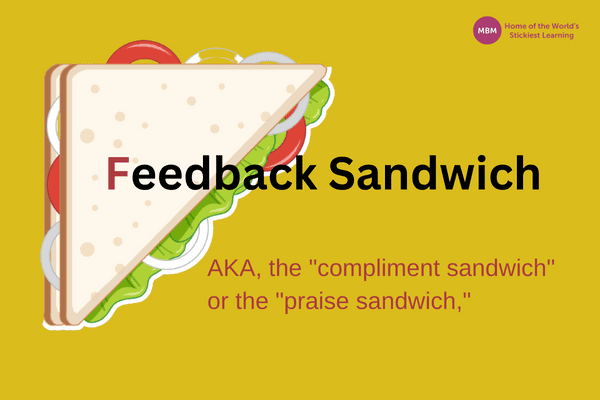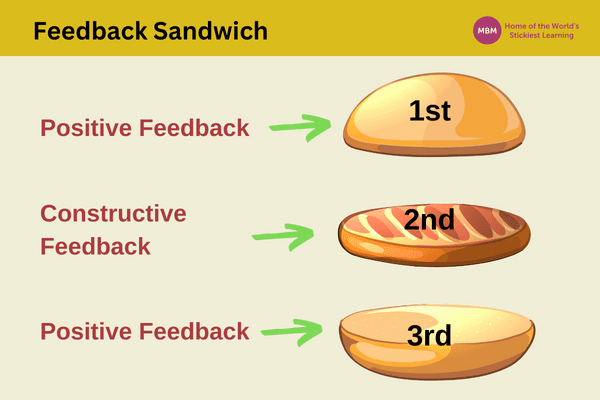Like Making the Perfect Burger, Here’s How to Give Feedback That People Want to Hear!
What’s the deal with this ‘feedback sandwich?’
Well, do you remember the last time you received feedback that left you feeling demoralised and defeated? Perhaps it was a criticism from a boss or a negative review from a client. We’ve all been there, and we know how disheartening it can be.
But what if there was a way to deliver feedback that could be constructive, supportive, and even inspiring? Enter the feedback sandwich – a technique that has gained popularity in recent years for its ability to balance negative feedback with positive reinforcement.
In this article, we’ll explore what the feedback sandwich is, how it works, and whether it’s the right tool for your feedback arsenal. So grab a cup of coffee, sit back, and let’s dive into the world of the feedback sandwich.
The feedback sandwich, also known as the “compliment sandwich” or the “praise sandwich,” is a communication technique that involves delivering feedback in a sandwich-like structure, with positive feedback on either side of constructive feedback. The idea behind the feedback sandwich is to make the feedback more palatable, easier to accept, and more likely to lead to positive change.
Jump to sections:
How it Works
Advantages
Disadvantages
Best Practices
Examples
Where Did the Feedback Sandwich Come From?
The feedback sandwich is believed to have originated from the world of counselling and therapy, where it was used as a tool to provide clients with difficult feedback in a supportive and non-threatening way.

Who Invented the Feedback Sandwich Method?
The ‘feedback sandwich’ was popularised in the 1980s by Mary Kay Ash, the founder of Mary Kay Cosmetics, who advised managers to sandwich any critical remarks between layers of praise.
Why is it so Popular?
A feedback sandwich is a popular tool for several reasons. First, it can be an effective way to balance negative feedback with positive reinforcement, which can help to reduce the impact of criticism and make it more digestible.
Second, it encourages the person receiving feedback to listen more actively and be more open to constructive criticism. Finally, it promotes a culture of support and encouragement, which can be beneficial for individual growth and overall team morale.
How Does the Feedback Sandwich Work?
The feedback sandwich is a communication technique that aims to provide constructive feedback in a supportive and balanced way. The structure of the feedback sandwich is simple: it begins with positive feedback, followed by constructive feedback, and ends with another round of positive feedback.
Positive Feedback:
The first layer of the feedback sandwich is positive feedback, which sets the tone for the conversation and establishes trust between the feedback giver and receiver. Positive feedback can take many forms, such as a compliment, an expression of appreciation, or recognition of a job well done. The purpose of positive feedback is to create a supportive and encouraging atmosphere that makes it easier for the person receiving feedback to be receptive to constructive feedback.
Constructive Feedback:
The meat of the feedback sandwich is constructive feedback, which is the main reason for the feedback conversation. This is where the feedback giver provides specific and actionable feedback that can help the person receiving feedback to improve their performance or behaviour. Constructive criticism should also be specific, avoiding generalisations or vague statements.
Positive Feedback Again:
The final layer of the feedback sandwich is another round of positive feedback, which serves to reinforce the person’s strengths, acknowledge their progress, or express confidence in their ability to improve. Positive feedback at the end of the conversation helps to leave a positive impression and can motivate the person to continue to work on the areas for improvement.

Why the Feedback Sandwich Technique is Effective?
First, positive feedback at the beginning and end of the conversation helps to create a supportive and non-threatening atmosphere that makes it easier for the person receiving feedback to be open to constructive feedback.
Second, constructive feedback is presented in a way that is specific and actionable, which makes it more likely to lead to meaningful change. Finally, the positive feedback at the end of the conversation helps to leave a positive impression and can motivate the person to continue to work on their areas for improvement.
However, it’s important to note that the feedback sandwich is not a one-size-fits-all approach, and it may not be appropriate for every situation or every person. The feedback sandwich requires skilful delivery and timing to be effective, and it may not be suitable for more serious or urgent feedback situations. Additionally, some critics argue that the feedback sandwich can come across as insincere or manipulative and that it can dilute the impact of constructive feedback.

Advantages of the Feedback Sandwich
In this section, we’ll explore the benefits of using the feedback sandwich and why it’s a useful tool for leaders, managers, and anyone who wants to provide feedback that is constructive and supportive.
1. Balances Negative Feedback With Positive Feedback
One of the main advantages of using the feedback sandwich is that it helps to balance negative feedback with positive feedback. By starting and ending the feedback conversation with positive feedback, the feedback giver can create a more supportive and non-threatening atmosphere that makes it easier for the person receiving feedback to be receptive to constructive feedback.
2. Encourages People to Listen More
Another advantage of using the feedback sandwich is that it encourages people to listen more to the feedback. When people receive positive feedback at the beginning of the conversation, they are more likely to be open to the feedback that will follow. This approach helps to build trust between the feedback giver and receiver and can lead to a more productive and meaningful feedback conversation.
3. Promotes a Constructive and Supportive Feedback Culture
The feedback sandwich also promotes a constructive and supportive feedback culture. When people receive feedback that is balanced and supportive, they are more likely to be motivated to work on the areas for improvement. This approach helps to create a culture where feedback is seen as a tool for growth and development.
4. Increases the Likelihood of Meaningful Change
Finally, the feedback sandwich increases the likelihood of meaningful change. When people receive feedback that is specific and actionable, they are more likely to be able to make changes that lead to improvement. The feedback sandwich helps to ensure that the feedback is given in a way that is clear and respectful. With a focus on actions and behaviours rather than on the person’s character or personality.
Disadvantages of the Feedback Sandwich
While the feedback sandwich has its advantages, it’s not without its criticisms and limitations. In this section, we’ll explore some of the disadvantages of using the feedback sandwich:
1. Can Be Seen as Manipulative or Insincere
One of the main criticisms of the feedback sandwich is that it can be seen as manipulative or insincere. When people receive feedback that starts and ends with positive comments, they may feel that the negative feedback is being softened or sugar-coated.
2. May Not Work in All Situations
Another disadvantage of using the feedback sandwich is that it may not work in all situations. For example, if the feedback is about a serious or urgent issue, using the feedback sandwich may not be appropriate as it may downplay the seriousness of the situation.
3. Can Be Difficult to Deliver Effectively
Delivering feedback using the feedback sandwich can also be challenging. The feedback giver needs to be skilled in delivering both positive and negative feedback in a way that is clear. They also need to ensure that the positive feedback is genuine and specific.
5. May Not Address Underlying Issues
Finally, the feedback sandwich may not address underlying issues that are contributing to the problem. By focusing on surface-level behaviours or actions, the feedback giver may miss the root cause of the issue.
Best Practices for Using the Feedback Sandwich

Here are some tips and advice for delivering feedback using the feedback sandwich approach:
#1 – Structure the Feedback
When using the feedback sandwich, it’s important to structure the feedback in a way that follows the positive-negative-positive sequence. Start by identifying the person’s strengths or positive behaviours and acknowledge them. Then, provide specific and constructive feedback on areas for improvement. Finally, end with a positive comment that reinforces the person’s strengths and encourages them to continue to improve.
#2 – Choose the Right Words
The words you choose when delivering feedback using the feedback sandwich approach are critical. Use language that is clear, specific, and focused on behaviours and actions rather than on the person’s character or personality.
Avoid using generalisations or sweeping statements, and instead, provide concrete examples to illustrate your points. Also, choose words that are respectful and empathetic, and avoid using language that is judgmental or accusatory.
#3 – Be Authentic and Meaningful
Authenticity is key when using the feedback sandwich. People can sense when feedback is insincere or manipulative, and it can undermine the credibility of the feedback giver. Make sure that the positive feedback is genuine and specific, and that the negative feedback is delivered with empathy and a desire to help the person improve.
#4 – Provide Follow-up and Support
Finally, it’s important to provide follow-up and support when using the feedback sandwich approach. After delivering the feedback, check in with the person and ask how they are doing. Offer your support and guidance, and provide resources or training if necessary.
Interested in training? We also offer a communication skills training course.
Here’s How You Might Structure the Feedback Using the Feedback Sandwich Approach:
Positive Feedback
Start by identifying the person’s strengths or positive behaviours and acknowledge them. For example, you might say something like:
I want to start by saying that I appreciate your hard work and dedication during this project. You were always on time for meetings, and your attention to detail was impressive.”
Constructive Feedback
Next, provide specific and constructive feedback on areas for improvement. For example, you might say something like:
However, there were a few instances where your communication with the team could have been improved. In particular, I noticed that you tended to dominate discussions and didn’t always listen carefully to others’ ideas. This caused some frustration and confusion among the team members.”
Positive Feedback
Finally, end with a positive comment that reinforces the person’s strengths and encourages them to continue to improve. For example, you might say something like:
That being said, I do not doubt that you have the potential to be an excellent team player. Your dedication and attention to detail are invaluable, and I’m confident that you will improve with some practice and feedback.”
Examples of the Feedback Sandwich in Action

Workplace Example:
A manager uses the feedback sandwich to provide feedback to an employee struggling with time management. The manager starts with positive feedback, acknowledging the employee’s strengths and past successes. Next, they provide specific feedback on areas for improvement, such as missed deadlines or incomplete tasks. Finally, they end with positive feedback, encouraging the employee to seek out resources for time management training or coaching.
Education Example:
A teacher uses the feedback sandwich to provide feedback to a student on a writing assignment. The teacher starts with positive feedback, highlighting the student’s strong points and identifying areas where they excelled. Next, they provide specific feedback on areas for improvement, such as sentence structure or clarity of ideas. Finally, they end with positive feedback, encouraging the student to continue working on their writing skills and offering resources for additional support.
Personal Relationships Example:
The friend starts with positive feedback, expressing appreciation for the loved one’s positive qualities and contributions to the relationship. Next, they provide specific feedback on the problematic behaviour and how it affects the relationship. Finally, they end with positive feedback, expressing their desire to work together to address the issue and strengthen the relationship.
Alternative Feedback Methods
While the feedback sandwich approach has its advantages, it’s not the only method of delivering feedback. Here are a few alternative approaches that may be more appropriate for certain situations or types of feedback:
Pendleton Model:
This model involves starting with negative feedback and then moving on to positive feedback. It is a more direct approach than the feedback sandwich, as it places negative feedback at the forefront.
Situation-Behavior-Impact (SBI) model:
This model involves describing a specific situation, the behaviour observed in that situation, and the impact of that behaviour on others. This approach is helpful for providing clear, specific feedback and for avoiding generalisations.
Nonviolent Communication (NVC):
This approach involves focusing on the needs and feelings of the person receiving the feedback, rather than on the behaviour itself. It is a compassionate and empathetic approach that can help to build trust and understanding.
Each of these approaches has its advantages and limitations, and it’s important to choose the approach that is most appropriate for the situation and the individuals involved. Ultimately, the goal of providing feedback is to help the recipient grow and improve, and the approach chosen should support that goal.
Conclusion
In conclusion, the feedback sandwich is a communication technique that has gained popularity for its ability to balance negative feedback with positive reinforcement. It can be a powerful tool for promoting a culture of support and growth, but it’s important to use it wisely and with skill.
Action: For even more useful content on communication, check out our ultimate guide on communication skills.




